It’s not the speed, but the volume: timber transport on rails
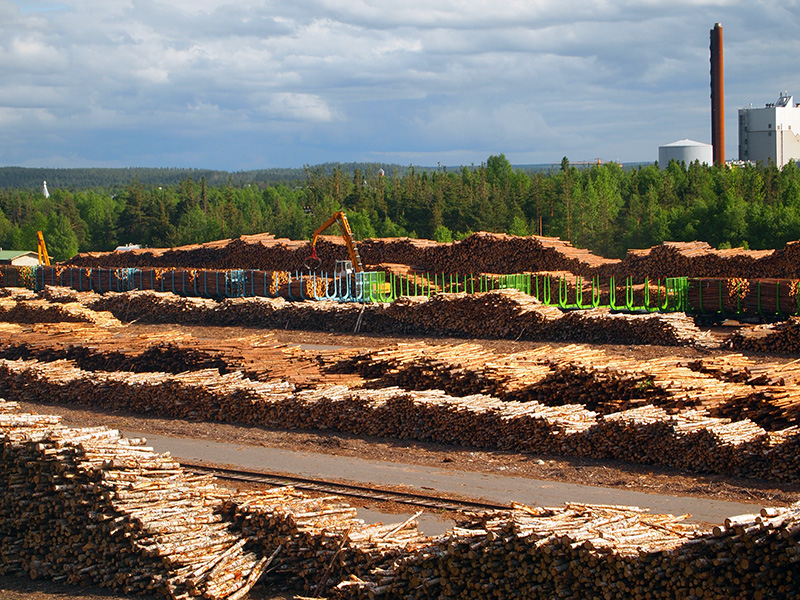
Tourists arriving at the railway station in Kolari in Finnish Lapland may wonder if the railway is profitable. Maybe they forget to compute in the forest sector.
The departure of a freight train is unlike that of a passenger train – at least if you compare what it feels like inside the wagon. Mr. Tapani Hautamäki, engine driver, turns on the power of the Soviet-made Sr1 engine of VR Transport, the Finnish state-owned railway company, and the ride begins with fits and starts.
There is a ”steering wheel” in the engine – not for steering, but for regulating the power. After the initial adjustment the speed is generally kept steady. There is no need for the driver to step on it.
All in all, over 1,800 tons of pulpwood rattles slowly on from the Rovaniemi railway station towards Kemi and the pulp mill of Metsä Fibre. The time is 19.12, and the one hundred kilometres to the Kemi railway station will take some two hours.
Behind us there are 22 wagonloads of timber from the Finnish state-owned forestry company Metsähallitus, 1,100 cubic metres in total. Of the timber delivered by Metsähallitus a quarter, or 1.5 million cubic metres, is transported by rail annually. In Lapland, Metsähallitus manages a greater share, as much as 60 percent, of its long-distance transports by rail than in other parts of the country.
Looking at overall national statistics, the share of rail transport of long-distance transport was 37 per cent in 2013, in both cubic metres and kilometres. The largest share was transported by trucks, 57 per cent, while the share of transport by water was six per cent.
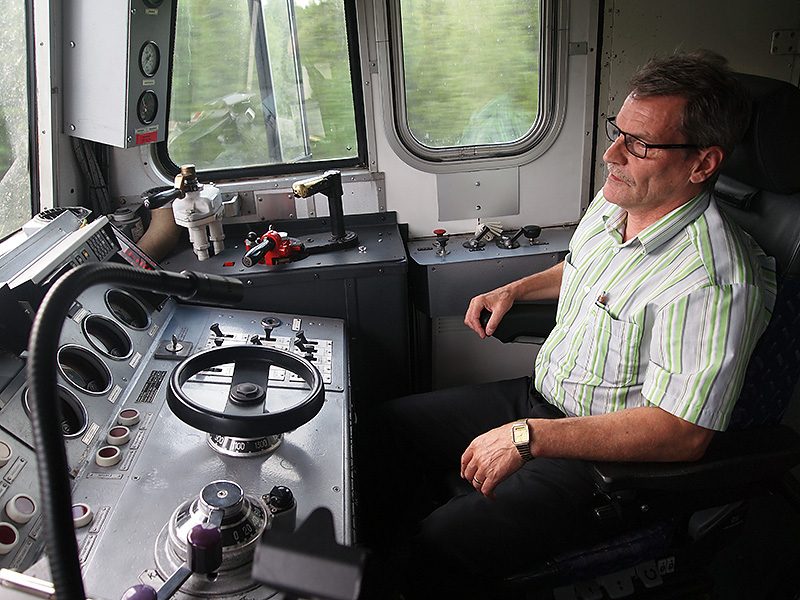
Scenery changes slowly
The ride is as smooth as butter, with the maximum allowable speed at 80 kilometres per hour. The scenery changes slowly before our eyes and for every hump and hillock, there seems to be a story to tell.
”This is where I once saw a bear. Not that you can be absolutely certain, but the way it crossed that ditch, it couldn’t be anything else. And there’s nothing but forest in that direction, for tens of kilometres,” says Hautamäki and points to the west with his hand.
”This field has been used to feed deer. Those barns are where they store the hay. The deer population has lately spread out from Kemi halfway to Rovaniemi, as well as to the east,” says Hautamäki.
What is it like driving a freight train? ”You have to be more punctual with passenger trains. The departures are different and so is the responsibility,” says Hautamäki.
More power is needed going uphill, and the speed drops to 35 kilometres per hour. ”There is no sense in speeding up. It would not save much time, but we’d use a great deal more energy,” says Hautamäki.
Apart from climbing the hills, we travel long distances with the engine disengaged. The terrain is mostly flat or downhill, which is because the railway follows the Kemijoki river faithfully towards the sea.
The train travels very well in dry summer conditions. Things are different with winter snows or rainy days, when the rainfall makes the rails slippery.
The darkness of winter night, and of days as well, strains the nerves, when there is nothing to see outside and the so-called daylight hours number only about six each day. Even then, they can hardly be called ’daylight’, more like a sort of dusk.
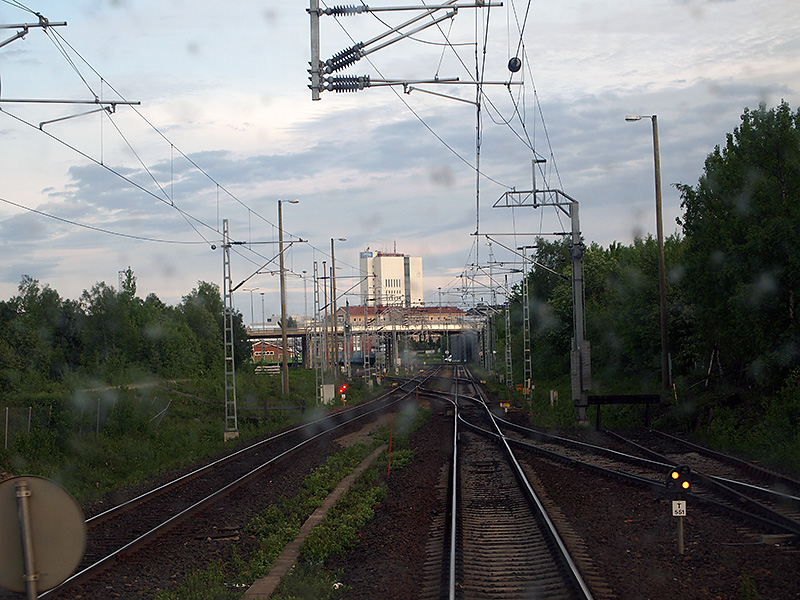
Transport by rail is usually long-distance
A great deal of timber is transported on the railways of northern Finland. One of the nodes of this traffic is Kemi, the location of Metsä Fibre’s pulp mill and Stora Enso’s pulp and paper mills as well as its sawmill.
Electrical engines pull timber trains to the Kemi railway station, and the timber is then taken on to the mills by shunting engines along terminal tracks.
One train unit normally has 22 wagons and is nearly half a kilometre in length.
The strength of railway transportation is manifested by the fact that it covers extremely long distances. In Finland, the average distance of timber transports by truck is roughly one hundred kilometres, but the whole railway transport chain covers more than 300 kilometres on an average, and just 50 kilometres of that consist of transport by trucks from forest to the railway terminals.
There are three timber terminals in Lapland: Kolari, Rovaniemi and Kemijärvi. From the south, timber comes to Kemi from as far as Ylivieska on the main railway line and from Kontiomäki in the east. Conversely, very little timber leaves Kemi to go south by rail.
Logistics becomes more and more efficient
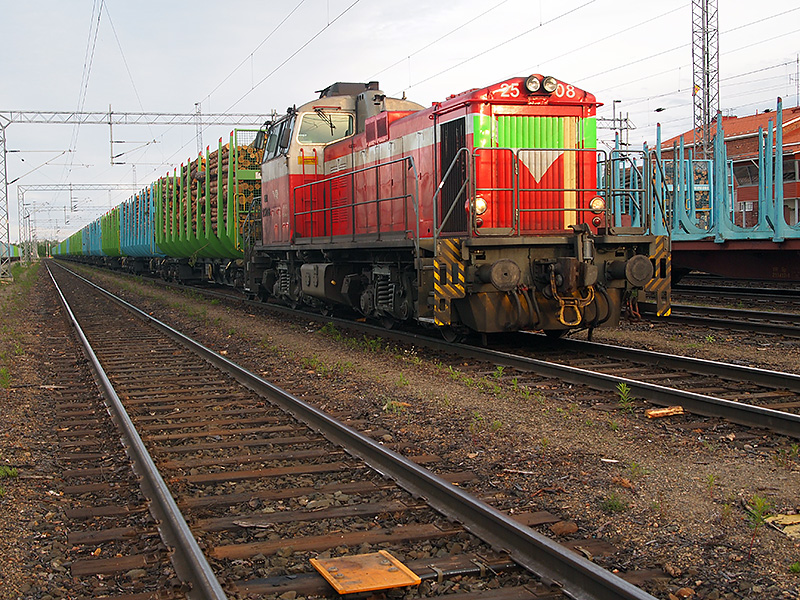
The efficiency of railway transport has increased greatly in recent times. Some years ago, the wagons in one train coming to Kemi could have different destinations.
This is why the trains going to each mill had to be assembled at the Kemi shunting yard. Today, the trains are assembled at the terminals so that they can be driven to the mill without reassembly.
Timber transports are important for the railways of the north. The freight traffic in the Kemi railway yard consists almost exclusively of timber. From the direction of Rovaniemi, two timber trains come to Kemi daily, while 3–4 trains come from Kolari each week.
Passenger trains travel on the Kolari railway section only during the tourism season. During the season, the train carries thousands of tourists and their cars to Kolari.
Still, very few passengers are likely to realize that this is only possible because of the dynamic forest sector in Finland, which is able to grow, harvest and transport the northern timber and finally manufacture products from it for the world market in a profitable and sustainable way.
Rails are packed with traffic
We arrive at Isohaara, where the track crosses the Kemijoki river by a bridge built on top of the dam of a hydropower plant. One moment, and we will see the high city hall of Kemi in the horizon.
In Kemi, the engine is released from our train and reattached to a train consisting of empty timber transport wagons, to head immediately to Kontiomäki in order to be loaded there in the morning for a return to Kemi.
This train will also take Hautamäki to his home in Oulu. It is a quarter past nine in the evening.
From now on our workhorse will be a Dv12 diesel engine, manufactured by the Finnish company Valmet. This engine pulls in both directions. It arrives to the end of the train we just pulled in to Kemi, with brakes screeching and dropping a load of fine sand on the track.
Why the sand? Because sand on the rails increases friction considerably. It is not because the Dv12 has not enough power to pull the train, but because the train may be too light, so that the wheels have not enough traction. Fine sand on the rails is a very good solution to this problem.
The engine is attached to the train, but we then find that we cannot go to Metsä Fibre, because the mill’s unloading yard is full. We do not know the reason, but we do know that unloading is going on in the yard.
So, a change of plans is needed. When we came to Kemi, another timber train was coming from the Kemijärvi terminal some kilometres behind us, heading to Stora Enso. We now decide to pull this train first to the Stora Enso mill.
Oystercatcher is nesting between rails
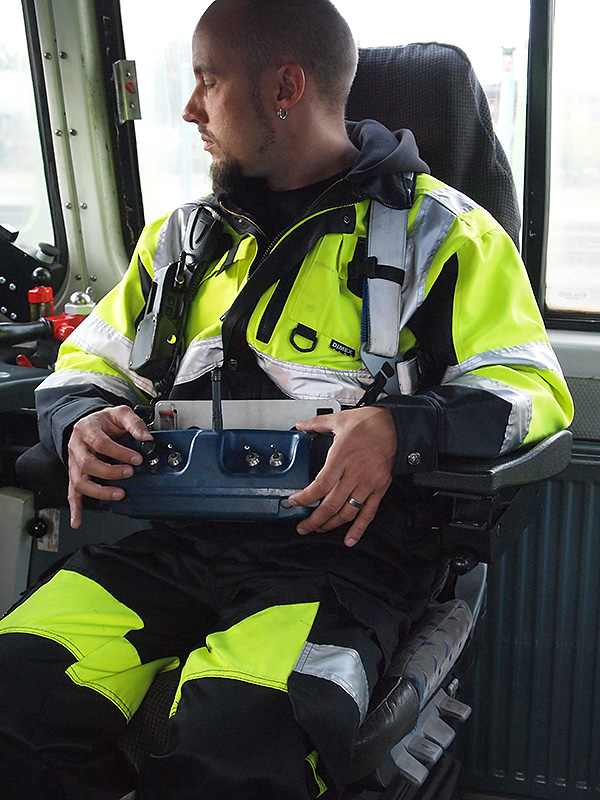
Again we move our engine back and forth, and then the trip begins. Mr. Ville Kaltio, supervisor at the shunting yard, asks the traffic control in Oulu for permission to leave. The people in Oulu set the switches in the right position by radio and give the permission.
The couple of kilometres to the unloading yard at the pulp mill pass slowly at the speed of 30 kilometres per hour. We clatter through an area of slumbering detached houses on the outskirts of Kemi.
“Oystercatcher really is a weird bird, insisting on building its nest on the line,” Kaltio comments on the bird flying in front of us as we make it to the yard. And indeed, this creature (Haematopus ostralegus) seems to be a railway aficionada.
“This is a dead-end track, so we have to push the train into it,” explains Mr. Marko Mylly, shunting supervisor. So, first of all, we have to move the engine from one end of the train to the other along a parallel track.
Pushing is done by radio steering, like all work in Finnish shunting yards since 2008. The supervisors steer the engine by a laptop radio device. At the Stora Enso yard, the supervisor walks beside the front wagon and uses the radio device to steer the engine pushing at the other end, half a kilometre away.
We start moving. The engine revs up and starts to move, but then the wheels lose traction.
“Seems like the sand ran out,” the chaps laugh. Little by little the engine gets moving. As we know, the main point is not the speed of travelling, but getting there in the end.
Late, and later
We return to Kemi at about eleven at night.
We now get to the train to Metsä Fibre. The line going there is a bit difficult because of quite a steep hill at the very start – that is, steep for a train, though hardly noticeable otherwise – with a simultaneous sharp swing to the left.
“This is a difficult spot especially in winter, but today it’s easy as pie,” says Mylly.
The surroundings resemble those of the previous trip: one-family houses on the seaside. Then the rails suddenly start to clatter.
“We just moved from state-owned to privately-owned tracks,” says Mylly with a slight pride in his voice.
At Metsä Fibre, the other trains are just about sorted out and they are ready to deal with the one we brought. On returning, we pull one empty train with us to the Kemi shunting yard.
The last job of the day is to leave the engine ready for the next shift, beginning at 5 o’clock in the morning. So, just lock the doors of the engine and go home to sleep.
It is twelve midnight.
Map of Finnish railroads as well as locations of the places mentioned in the article
Video: Motion of timber train
Homepage of the VR Group
Follow the motion of passenger trains in Finland in real time – click the word “Junahaku” and scroll to come closer

Kirjoita kommentti